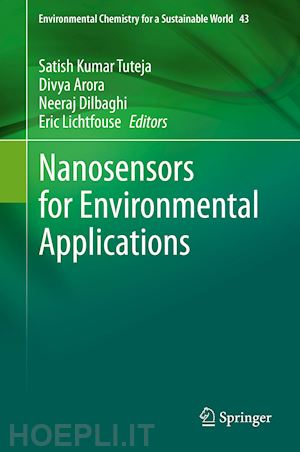
Questo prodotto usufruisce delle SPEDIZIONI GRATIS
selezionando l'opzione Corriere Veloce in fase di ordine.
Pagabile anche con Carta della cultura giovani e del merito, 18App Bonus Cultura e Carta del Docente
Preface (Satish Tuteja, Divya Arora, Neeraj Dilbaghi, Eric Lichtfouse).- 1. Biosensors applications in the detection of heavy metals, polychlorinated biphenyls, biological oxygen demand, endocrine disruptors, hormones, dioxin, phenolic and organophosphorus compounds (Madan L. Verma).- 2. Biofunctionalized nanostructured materials for sensing of pesticides (Jyotsana Mehta).- 3. Analytical detection of pesticides, pollutants and pharmaceutical waste in the environment (Elsa M. Materon).- 4. Two-dimensional transition metal dichalcogenides for gas sensing applications (Nirav Joshi).- 5. Carbon nanolights as optical nanosensors for water contaminants (Vinay Sharma, Shaikh M Mobin).- 6. Point-of-care sensors for on-site detection of pesticides (Neeti Kalyani).- 7. Development of optical sensor strips for point-of-care testing for pesticide (Satish Kumar Pandey).- 8. Metals and ions detection using electrochemical and wireless sensor (Rajnish Kaur).
Satish Kumar Tuteja graduated with his PhD degree in Biosensor Engineering at Nanoscience and Nanotechnology Department of CSIR-CSIO, AcSIR of India in September 2016. His PhD thesis was on the development of nanostructures based ultra-sensitive electrochemical, biomedical and environmental biosensors. His research interests are in biosensor and diagnostic lab on a chip sensor development; surface functionalization and biointerface development; antibody and aptamer engineering for sensing, diagnostics and nanodevice fabrication. He completed his Mitacs Elevate Canada Post-doctoral fellowships at the BioNano Laboratory, University of Guelph, Canada and Currently, Dr. Satish is working as Senior Scientist (Alexander Von Humboldt Fellow) at Institute of Materials in Electrical Engineering1 (IWE1), RWTH University, Aachen, Germany and pursuing research on Cancer Diagnostics.
Divya Arora is currently working as Dr DS Kothari Fellow in Department of Bio& Nano Technology, Guru Jabheshwar University of Science & Technology, Hisar, Haryana. She received her Ph.D. from the Academy of Scientific and Innovative Research (AcSIR) at the CSIR-Indian Institute of Integrative Medicine, Jammu. She has been recipient of several international awards such as the Raman Charpak Fellowship from the Indo-French Centre for the Promotion of Advanced Research (IFCPAR), India, a travel ward for attending 4th AIST International Imaging Workshop at the National Institute of Advanced Industrial Science and Technology (AIST), Japan and the DST-DFG award for participation in 68th Nobel Laureate Meeting, Lindau, Germany. Dr. Arora has to her credit several international publications and is reviewer of various prestigious international journals. Her current research interests are Nanotechnology, Microbial Biotechnology & Natural Product Chemistry.
Neeraj Dilbaghi completed his doctorate degree in Microbiology from CCS Haryana Agricultural University, Hisar, India and is presently working as Professor at the Department of Bio and Nano Technology, Guru Jambheshwar University of Science and Technology, Hisar, India. Dr. Dilbaghi holds the position of Director, UGC- Human Resource Development Centre (HRDC) and Incharge Radioecology Centre of GJUS&T, Hisar. He has over 23 years of research and Teaching experience. During his professional career Dr. Neeraj Dilbaghi has guided 11 Ph.D. and over 40 M.Tech. Students. Presently, 8 Ph.D. students and one PDF are pursuing research under his guidance. His current research focuses on Microbial Biotechnology, Bionanotechnology and Nanosensors for healthcare and environmental applications, Nano medicine and Drug Delivery and Toxicological evaluation of nanomaterials. Prof. Neeraj Dilbaghi has published over 130 research papers in peer reviewed international and national journals of repute. He has completed 3 UGC Major Research Projects, one project funded by BARC- BRNS, three project funded by DST including the prestigious Indo-Thailand International collaborative research project and presently handling 4 sponsored research projects funded by DBT, LSRB-DRDO, HSCS&T, BARC-BRNS and ADAMA-AGAN Ltd Israel etc to manage his research activities.
Eric Lichtfouse is research scientist at Aix-Marseille University and invited professor at Xi'an Jiaotong University. He has invented 13C-dating following the discovery of temporal pools of molecular substances in environmental samples. His research interests include climate change, carbon, pollution and organic compounds in air, water, soils and sediments. He his teaching biogeochemistry and scientific writing, and is the author of the book Scientific Writing for Impact Factor Journals, which include an innovative writing tool: the Micro-Article. He is chief editor of the journal Environmental Chemistry Letters, and the book series Sustainable Agriculture Reviews and Environmental Chemistry for a Sustainable World.











Il sito utilizza cookie ed altri strumenti di tracciamento che raccolgono informazioni dal dispositivo dell’utente. Oltre ai cookie tecnici ed analitici aggregati, strettamente necessari per il funzionamento di questo sito web, previo consenso dell’utente possono essere installati cookie di profilazione e marketing e cookie dei social media. Cliccando su “Accetto tutti i cookie” saranno attivate tutte le categorie di cookie. Per accettare solo deterninate categorie di cookie, cliccare invece su “Impostazioni cookie”. Chiudendo il banner o continuando a navigare saranno installati solo cookie tecnici. Per maggiori dettagli, consultare la Cookie Policy.